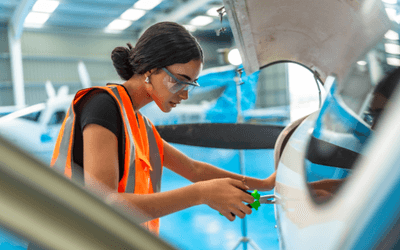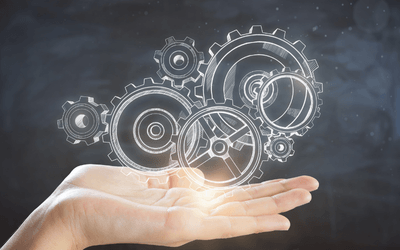Artificial intelligence (AI) has long been a hot topic across various industries. People are keen to know how automation could affect their businesses and/or careers. This has continued to grow as AI enters the mainstream in a range of ways.
Studies show that almost 77% of devices today use AI technology in some way, and there will soon be more AI assistants (such as Amazon Alexa) than people on this planet! Meanwhile, the AI market itself is predicted to reach $407 billion by 2027.
But behind all of the fascinating statistics are real-life pros and cons of AI. In this blog, we’ll hone in on the construction and engineering industries, to see how AI could affect them. These are two areas where AI is already being frequently used, and research by the Midwest Economic Policy Institute (MEPI) estimates that by 2057, robots could replace or displace 2.7 million jobs in construction and engineering.
So how could AI affect the construction and engineering industries? Here are some advantages and disadvantages.
Advantages of AI
Greater productivity
This was the original purpose of automation, and it definitely applies in industries like construction and engineering. Essentially, AI can free up human workers to go where they add the most value. For example, some construction companies are using self-driving machinery to do repetitive tasks such as welding or pouring concrete. The human workers can then focus on the construction work itself, making projects run smoother.
Companies are also increasingly relying on off-site factories. This is when components of a building are pieced together off-site by robots, before then moving over to the construction site to be finalised by humans. Examples include walls – the structure can be assembled by AI, leaving human workers to complete the finer details such as plumbing and electrical systems.
Enhanced quality
The speed and accuracy of machine learning don’t just make tasks more efficient – it makes them better. There are already some great examples of this within engineering when you look at tasks such as design and simulation. AI is often embedded within Computer Aided Design (CAD), making it smarter and eliminating any potential discrepancies. These tools help engineers explore options that otherwise wouldn’t be possible – for example, design and weight-saving options.
Similarly, AI is really helpful when engineers are working on public infrastructure projects. They use it to predict things like footfall, meaning decisions are made with evidence behind them rather than a gut feeling. It can even help promising candidates with interview prep.
More accurate budgets and timelines
Think about how many projects you hear about that run over the deadline, and therefore cost more. This is something AI can help mitigate. For example, Artificial Neural Networks can create predictive models, by looking at historical data and other factors such as project size and the experience of Project Managers. This can then be used to give a much more accurate idea of costs and timings – meaning happier stakeholders at the end of it all.
A safer workplace
Construction and engineering can both be high-risk industries, so it makes sense to use robots for some of the more dangerous jobs. A good example within construction is the use of drones, which has made reporting and site evaluations much safer. Other areas include using robots to lift heavy equipment or dig for fuels which could be poisonous to humans.
Another benefit of using AI is that, unlike humans, robots don’t get tired. Therefore, accidents which can happen as a result of human error or fatigue are reduced.
The safety benefits of AI go beyond operating machinery as well. There’ve been instances of companies using it to track and stop the spread of viruses such as COVID-19, by seeing exactly which colleagues an infected employee has interacted with.
Although automation was originally used to increase productivity and replace tiresome tasks, there’s no doubt that the workplace can also be made safer through AI.
Non-stop ability
Robots don’t require lunch breaks, holidays or sick days. They can be set to work on a repetitive cycle unless programmed otherwise. As long as the machine is maintained and programmed correctly, it can work without stopping. This helps businesses to achieve tight deadlines and ensure a 24/7 production line.
Disadvantages of AI
High costs
Maintaining a robot can be extremely expensive – ultimately, they are highly complex machines which require big investments. Just to give you one example, Apple’s SIRI software cost the company $200 million to acquire and get off the ground!
Not only are robots extremely intricate to set up, but they have huge ongoing costs for repair and maintenance. They have software programmes that need frequent upgrading, so they can meet the needs of the constantly changing environment.
Now, further developments and economies of scale might change things in the future – but right now, these costs mean that not all organisations can afford to invest in robots.
Unemployment may rise
One of the biggest fears people have is the potential job losses AI can lead to. While this isn’t always the case (as mentioned earlier, it allows humans to go where they can add value), there are still instances where people will be made redundant altogether. In some industries, this has been seen with the axing of customer service agents in favour of chatbots.
People who work in areas that are most at risk of being replaced will need to receive training. This will help them add to their skillset and have multiple strings to their bow – allowing them to stay ahead of the machines.
Lack of personality
Robots serve a very functional purpose. Ultimately, they are machines which don’t have feelings or the human touch. This can be a problem in any industry, as they can’t think outside of the box. For example, a human working on a construction site can be flexible if they come across a particular problem, and come up with a bespoke solution. A robot, on the other hand, will be programmed to do the same thing regardless of the situation. When it comes to creativity, nothing can beat a human mind.
Security risks
As is the case with most technologies, AI software can be vulnerable to outside attacks, such as data manipulation, theft and a whole lot more. The impact can be even worse because AI specifically makes decisions by processing data. If the initial data being fed in has been tampered with – for example by a hacker – this could lead to projects being damaged rather than improved.
Robots don’t get better with experience…yet
Unlike humans, AI cannot be improved with experience. Machines may be able to store enormous amounts of data, but the storage isn’t as effective as the human brain. Over time, it can be susceptible to wear and tear. It stores a lot of data but the way it can be accessed and used is very different from human intelligence.
AI is here to stay, and there’s no question that it has pros and cons. But while it’s still in a developing stage (as opposed to the mass takeover people fear), humans still have the upper hand. The key is knowing what the benefits are so we can make the most of them, and knowing what the risks are so we can avoid them.
Are you looking for recruitment support within construction and engineering? Get in touch today.









